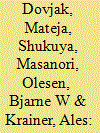| Srl | Item |
| 1 |
ID:
096137


|
|
|
|
|
| Publication |
2010.
|
| Summary/Abstract |
Problem of high energy use for heating in Slovenian buildings is analyzed with exergy and energy analysis. Results of both are compared and discussed. Three cases of exterior building walls are located in three climatic zones in winter conditions. Results of energy analyses show that the highest heating energy demand appears in the case with less thermal insulation, especially in colder climate. If the comparison is made only on the energy supply and exergy supply, the results of exergy analysis are the same as those of energy analysis. The main difference appears, if the whole chain of supply and demand is taken into consideration. Exergy calculations enable us to analyze how much exergy is consumed in which part, from boiler to building envelope. They also reveal how much energy is supplied for the purpose of heating. Results show that insulation has much bigger effect than effect of boiler efficiency. However, the most effective solution is to improve building envelope together with boiler efficiency. Better thermal insulation also makes an important contribution to the improvement of thermal comfort conditions. It causes higher surface temperatures resulting in a larger warm radiant exergy emission rate and consequently better thermal comfort.
|
|
|
|
|
|
|
|
|
|
|
|
|
|
|
|
| 2 |
ID:
096135


|
|
|
|
|
| Publication |
2010.
|
| Summary/Abstract |
Much focus is put on measures to improve the building envelope system performance to reduce the impact of the building sector on the global environmental degradation. This paper compares the potential of building envelope improvements to those of a change in the occupant's behavioural pattern. Three cases of improvements together with a base case were analysed using exergy analysis, because the exergy concept is useful to understand the underlying processes and the necessary adjustments to the calculation of the heat-pump system. The assumptions for the occupant behaviour were set up based on our field measurements conducted in a dormitory building and the calculation was for steady-state conditions. It was found that the potential of occupant behavioural changes for the reduction in exergy consumption is more affected by the outdoor temperature compared to building envelope improvements. The influence of occupant behaviour was highly significant (more than 90% decrease of exergy consumption) when the temperature difference between indoors and outdoors is small, which is the case for long periods in regions with moderate temperatures during summer and/or winter. Nevertheless, both measures combined lead to a reduction from 76% up to 95% depending on the outside conditions and should be the final goal.
|
|
|
|
|
|
|
|
|
|
|
|
|
|
|
|
| 3 |
ID:
101410


|
|
|
|
|
| Publication |
2011.
|
| Summary/Abstract |
These days the number of projects trying to urge a change in the occupant's behaviour towards a sustainable one is increasing. However, still less is known about the effect of such measures. This paper describes the findings of two investigations, a field measurement and an Internet-based survey, both including the dissemination of information about strategies for a high level of comfort without much energy usage. The focus was on the ability to quantify the effect of such measures on the heating and cooling behaviour. As a result, those who participated in a workshop were more likely to change their behaviour than those who received an information brochure only; whether this was due to the method employed or the type of participants could not be ascertained. However, the workshop participants reduced their cooling device usage by up to 16%. The concept of exergy was used to show how this reduction affects the exergy consumption of the cooling device, because it enables us to consider the qualitative aspect of energy as a quantity to be calculated. This showed that the exergy consumed by the workshop group was reduced by up to 20% comparing their behaviour before and after the information dissemination.
|
|
|
|
|
|
|
|
|
|
|
|
|
|
|
|